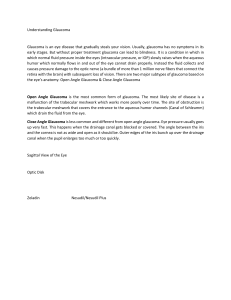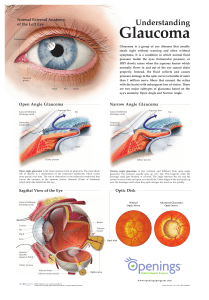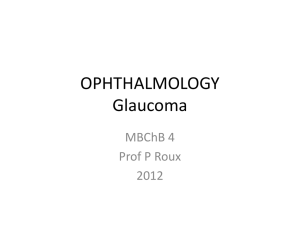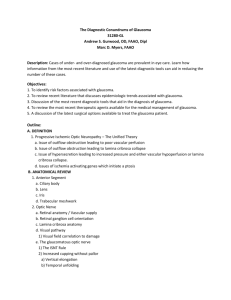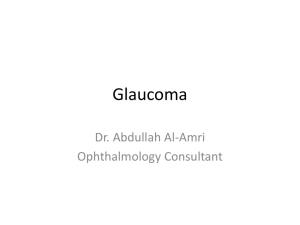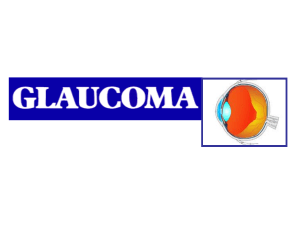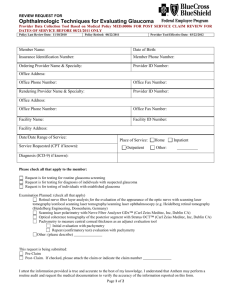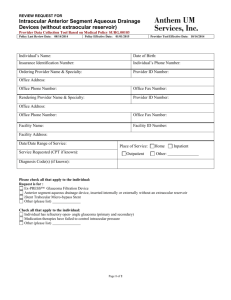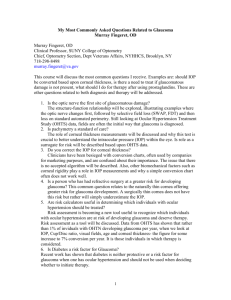Glaucoma-drops-GP-talk by
advertisement
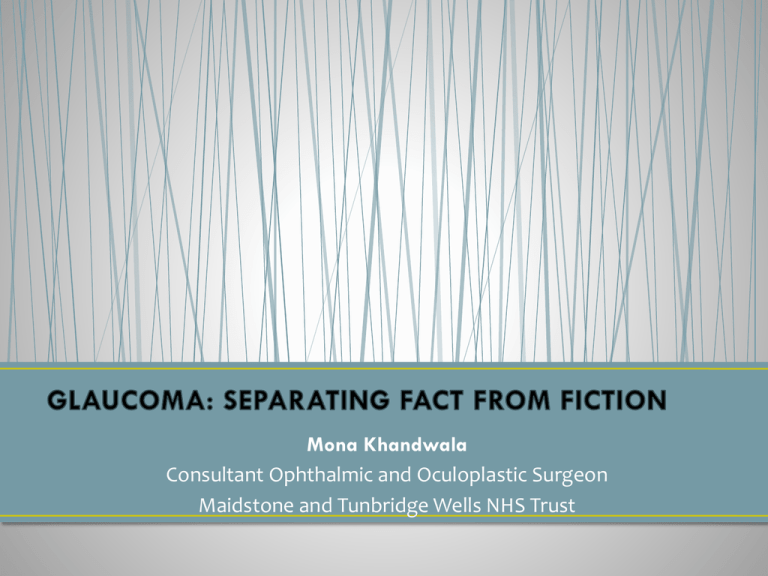
Mona Khandwala Consultant Ophthalmic and Oculoplastic Surgeon Maidstone and Tunbridge Wells NHS Trust ∗ ∗ ∗ ∗ Affects 3% of the adults 10% affected > 70 years of age Late diagnosis Amongst three most common causes of visual impairment Glaucoma is a form of optic neuropathy with specific visual field loss. It is usually associated with raised intra ocular pressure (IOP) • • Primary Open angle Secondary Closed angle Congenital ∗ Commonest form : > 60% adults with glaucoma ∗ Ageing of the drainage filter ∗ IOP rises, damages the optic nerve and causes field defects ∗ Usually asymptomatic: often picked up at routine eye tests ∗ Needs regular eye checks after age 40 years ∗ Variant- Normal tension glaucoma ∗ Can be insidious/ sudden onset ∗ Symptoms include: coloured halos around lights Ocular pain/ headache Cloudy/hazy vision Nausea and vomiting ∗ True ocular emergency- urgent referral ∗ Treatment can restore vision ∗ Enlargement of the eyeball ∗ Opacity of the cornea ∗ Excessive eye-watering ∗ Sensitivity to light (photophobia) 1. Open angle Steroids: ointment, inhalers, oral 2. Closed angle (by dilating the pupil) Tricyclic antidepressants, Mono amine oxidase inhibitor, Anti Parkinsons, Antihistamines, Antipsychotics, Antispasmolytics 3. Closed angle ( by rotation of ciliary body) Sulfonamides OPEN ANGLE ∗ Increased resistance to outflow ∗ Accumulation of glycosamino glycans (GAG) ∗ Decreased pinocytosis, causing decreased clearing of GAG ∗ Accumulation of protein that blocks the trabecular meshwork NARROW ANGLE ∗ Pupillary blockage ∗ Stimulating sympathetic / inhibiting parasympathetic activation causing pupil dilatation ∗ Anterior rotation of the ciliary body, with choroidal effusions, resulting in a shallow anterior chamber and blockage of the trabecular meshwork ∗ Pharmacological ∗ Laser ∗ Surgical DRUGS Timoptol, carteolol, betaxolol, levobulonol MECHANISM OF ACTION Decrease of aqueous production SIDE EFFECTS Bronchospasm, bradycardia, CCF, depression, confusion, impotence DRUG Brimonidine ( alphagan) MECHANISM OF ACTION Decreases aqueous production and resistance to outflow SIDE EFFECTS Conjunctival hyperaemia, allergic reactions, headache, malaise, SNC depression DRUGS MECHANISM OF ACTION Latanoprost, Increases travoprost, aqueous bimatoprost, outflow unoprostone SIDE EFFECTS Conjunctival hyperaemia, hypertrichosis, increased iris pigmentation DRUGS Dorzolamide, brinzolamide, acetazolamide MECHANISM OF ACTION Decrease aqueous production SIDE EFFECTS Paraesthesia, malaise, depression, anorexia, allergic reactions, renal calculi DRUGS MECHANISM OF ACTION Pilocarpine Increases aqueous outflow SIDE EFFECTS Eye/brow pain, increased myopia, poor vision Currently only 2 true preservative free drops: 1. Tafluprost PF (Saflutan) : £17.41 2. Latanoprost PF (Monopost): £8.49 OCULAR ∗ ∗ ∗ Hyperemia/ redness/ itching Thickening and lengthening of lashes (hypertrichosis) Darkening of iris colour SYSTEMIC ∗ ∗ ∗ ∗ ∗ ∗ ∗ Bronchospasm Bradycardia Paraesthesia Depression Impotence Anorexia Renal calculi ∗ Reduction of systemic absorption may be achieved by : Lacrimal occlusion for 3 minutes Merely closing the eyes for 3 minutes ∗ Contra indiations : Asthma, COPD, bradycardia, CCF and heart block. ∗ Beta-blockers should not be instilled at bedtime ∗ Iridotomy ∗ Laser trabeculoplasty ∗ Transscleral cyclodiode ∗ Iridoplasty Fragment removed Filtration bleb Valve ∗ Can glaucoma be hereditary? Not always. It is, however, more common among close blood relatives of affected persons ∗ Is it present for life? Once the glaucomatous disease develops it will remain forever even if treated ∗ Is it possible to have it in only one eye? Certainly, although both eyes are commonly affected with different degrees of severity ∗ Can it cause blindness? Yes, if the progression of the disease is not stopped with appropriate treatment ∗ Is it O.K. to drive? Yes, as long as the visual function is within the limits set by the DVLA ∗ Can glaucoma treatments improve the eyesight? No, the aim of the treatment is to prevent further deterioration of the visual function ∗ When is it advisable to have a preventive eye specialist examination? Over 40 years old and have not had an eye specialist examination within the previous 5 years. ∗ What is the vesicle that is visible by lifting the eyelid after the glaucoma operation? It is the conjunctiva raised by the aqueous humour that filters through the small valve that the surgeon has made in the eye wall. It is known as “ filtering bleb”, it may initially be uncomfortable though, usually, only temporarily. ∗ What happens if you forget to administer the eye-drops? Best to stick to set times ∗ If two types of eye-drops have to be administered at the same time, can you apply them together? It is necessary to wait a few minutes between drops ∗ If you are not sure that you have applied the first eye-drop correctly, is it dangerous to apply a second one? No, although it is best to dry the eye immediately, to prevent the extra eye-drop from flowing into the tear duct ∗ Is it dangerous to use the eye-drops more frequently than prescribed? No positive effects on treatment, and it could lead to side effects ∗ Is it possible to use other medication in addition to glaucoma drops? It is very important to tell the family doctor about the diagnosis of glaucoma and the medications being used. For instance, you should be careful when taking some tranquillisers, anti-asthmatics or medication for the digestive system ∗ How long does it take for the eyedrops to be absorbed? A few minutes. ∗ ∗ ∗ ∗ ∗ ∗ 35 yo African male, web designer Gradual diminution of vision Positive family history Vision: RE- 6/60, LE- 6/18 IOP: RE-23, LE-21 Bilateral visual field defects: RE- temporal loss, LE- inf altitudinal loss ∗ Colour vision: RE- 1/17, LE- 4/17 ∗MRI scan done- pituitary tumor ∗Post surgery good result ∗Vision : 6/6 BE ∗Colour vision: 17/17 ∗ 48 yo Caucasian female ∗ Routine optician check revealed suspicious optic discs ∗ Positive history of susceptibility to cold extremities in winter, and migraine ∗ Vision: RE- 6/6, LE-6/6 ∗ IOP- 20 mm Hg BE ∗ Optic discs- CD ratio of 0.75 with inferior rim loss ∗ Normal visual field tests ∗ No treatment started as no evidence of visual field involvement ∗ Ask history of vasospasm and migraine: NTG? ∗ Ask history of trauma, steroid usage, other drug history ∗ You are aged 60 or over ∗ You have diabetes or glaucoma ∗ You are 40 or over and have a close relative with glaucoma i.e. brother, sister, parent or child ∗ A hospital ophthalmologist says that you are at risk of glaucoma ∗ You are registered blind or partially sighted
